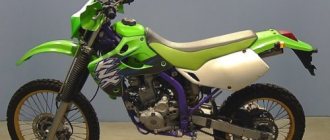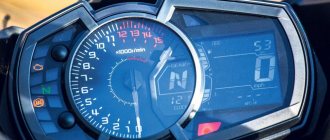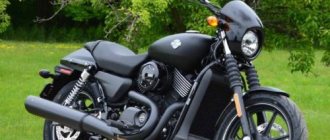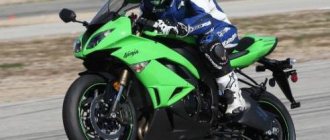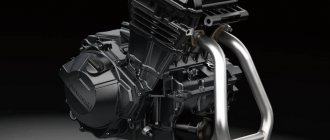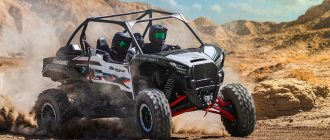D-TRACKER
- motorcycle model, Kawasaki brand,
The Kawasaki D-Tracker 250 motard model was first introduced in 1998 and is still in production. The first versions of the model were aimed mainly at the domestic Japanese market, but at different times they were sold in some countries of the world, incl. European, North American (USA, Canada) and Oceania (Australia). Since 2003, production of the Kawasaki D-Tracker 250 was completely transferred to Thailand, from where the motorcycle was distributed to many Asian countries.
The appearance of the Kawasaki D-Tracker 250 model was due to Kawasaki's desire to introduce to the market a factory motard - a class of motorcycles based on converting enduro-cross models into full-fledged road ones. The basis was taken from the lightweight enduro Kawasaki KLX 250, which received road wheels, more powerful brakes and retuned suspensions. As a result, a new model Kawasaki D-Tracker 250 appeared on the market, which had a 249 cc engine. cm (30 hp, 25.5 Nm), 17′ road-spoke wheels, steel frame and powerful disc brakes with a dry weight of only 118 kg.
Main generations of Kawasaki D-Tracker 250:
Kawasaki D-Tracker 250 (1998-2007) - first generation. Produces 30 hp. power, is equipped with a carburetor and has a fuel tank of 8 liters. The model was also sold under the name Suzuki SB250.
Kawasaki D-Tracker X (2008-) - second generation. Known as the KLX250SF in the North American and Australian markets. The model has a more modern appearance, an injector (KLX250SF - carburetor), brake discs of increased diameter, a 7.7 liter fuel tank and a power of 23 hp.
What do the owners say?
Many people advise buying a new bike rather than a used one. This recommendation is, of course, valid in any situation where the bike is still in production.
Owners note good maneuverability, ease of operation, maneuverability and low maintenance costs. This is natural, because since the equipment is still being produced, it will not be difficult to get spare parts if something happens.
Around 150 thousand Russian rubles - that’s how much such a motard costs. And many owners do not regret paying this money. They note that the cost corresponds to the characteristics and is acceptable for such a motorcycle. This price makes the equipment affordable for many.
As for the speed, of course, there are no delights. According to the description of the owners, the equipment is capable of quickly covering sections of rough terrain, but this does not reach the sporting level. However, few consider this a disadvantage. It would be strange to make claims against technology for its inability to do something for which it is not intended.
Those who have been riding motocross bikes for a long time and have ridden the Kawasaki D-Tracker 250 notice that they are no longer interested in this option. However, according to them, for beginners in motocross, this and many other motards are a good choice for the role of training equipment for learning.
In conclusion, the Kawasaki D-Tracker 250 is a good bike for different situations. This technique, judging by the reviews, is well suited for both urban environments and average off-road conditions; for beginners in motocross, this will be a good help
However, already established athletes are unlikely to pay attention to this model
Brief history of the model
1998 - start of production of Kawasaki D-Tracker 250. First generation of the motorcycle. Blue color. Model: Kawasaki D-Tracker 250. Frame number: LX250E-XXXXXX. Factory designation: KLX250-J1.
1999 - no significant changes. The model is officially available in Greece. Color: blue, green. Model: Kawasaki D-Tracker 250. Frame number: LX250E-XXXXXX. Factory designation: KLX250-J2.
2000 - model not produced. 2001 - no significant changes. Color: blue, black. Model: Kawasaki D-Tracker 250. Frame number: LX250E-XXXXXX. Factory designation: KLX250-J4.
2002 - no significant changes. Color: black, white. Model: Kawasaki D-Tracker 250. Frame number: LX250E-XXXXXX. Factory designation: KLX250-J5.
2003 - motorcycle production was completely transferred to Thailand. Color: black, orange. Model: Kawasaki D-Tracker 250. Frame number: LX250E-XXXXXX. Factory designation: KLX250-J6.
2004 - no significant changes. Color: black, white, blue. Model: Kawasaki D-Tracker 250. Frame number: LX250E-XXXXXX. Factory designation: KLX250-M1.
2005 - no significant changes. Color: black, green, blue. Model: Kawasaki D-Tracker 250. Frame number: LX250E-XXXXXX. Factory designation: KLX250-M2.
2006 - no significant changes. Color: black, green, white. Model: Kawasaki D-Tracker 250. Frame number: LX250E-XXXXXX. Factory designation: KLX250-M6F.
2007 is the last year of production of the Kawasaki D-Tracker 250 I generation. Color: green, purple, dark gray. Model: Kawasaki D-Tracker 250. Frame number: LX250E-XXXXXX. Factory designation: KLX250-M7F.
2008 - Second generation Kawasaki D-Tracker 250. The motorcycle changes its name to Kawasaki D-Tracker X. The model undergoes serious restyling (the design of plastic, headlights, and dashboard changes), receives an injector instead of a carburetor and more powerful front brakes ( 300mm disc vs 260mm). Color: black, yellow, purple. Model: Kawasaki D-Tracker X. Frame number: LX250V-XXXXXX. Factory designation: KLX250-V8F.
2009 - model available in North America and Australia. The official name in these markets is Kawasaki KLX250SF. Color: dark grey, orange, blue. Model: Kawasaki D-Tracker X (Asia). Frame number: LX250V-XXXXXX. Factory designation: KLX250-V9F.
Model: Kawasaki KLX250SF (North America, Australia). Frame number: LX250V-XXXXXX. Factory designation: KLX250-W9F.
2010 - Model available only in North American and Australian markets. Dark-blue colour. Model: Kawasaki KLX250SF. Frame number: LX250V-XXXXXX. Factory designation: KLX250-WAF.
2011 - no significant changes. Color: red-white, black-green. Model: Kawasaki D-Tracker X (Asia). Frame number: LX250V-XXXXXX. Factory designation: KLX250-VBF.
2012 - no significant changes. Color: white-blue, black-green. Model: Kawasaki D-Tracker X (Asia). Frame number: LX250V-XXXXXX. Factory designation: KLX250-VCF.
2013 - no significant changes. Color: black-red, black-white. Model: Kawasaki D-Tracker X (Asia). Frame number: LX250V-XXXXXX. Factory designation: KLX250-VDF.
2014 - no significant changes. Color: black-gray, black-green. Model: Kawasaki D-Tracker X (Asia). Frame number: LX250V-XXXXXX. Factory designation: KLX250-VEF.
2015 - no significant changes. Model: Kawasaki D-Tracker X (Asia). Frame number: LX250V-XXXXXX. Factory designation: KLX250-VFF.
2016 is the last year of sales of the motorcycle on the Japanese market (the model is still available on the Asian market). Model: Kawasaki D-Tracker X (Asia). Frame number: LX250V-XXXXXX. Factory designation: KLX250-VGF, KLX250-VGS.
2017 is the final production year. Model: Kawasaki D-Tracker X (Asia). Factory designation: KLX250-VKF.
Comfort
Not bad for off-road use, unlike sport bikes and road motorcycles. The convenience is that such a bike will be comfortable in the city too. In general, it is difficult to imagine a car more versatile and suitable for a beginner.
An excellent choice for those who need an economical vehicle for all occasions, and who prefer motorcycles to cars.
Almost every review of this motard notes that the model is not suitable for competitions, but is not bad as a training bike for beginners. Of course, compared to many Kawasaki road bikes, the D-Tracker 250 is not nearly as comfortable. But they also note that it is more comfortable than many cross-country options.
https://youtube.com/watch?v=m4lQ09_po4I
Specifications:
| Model | Kawasaki D-Tracker 250 (since 2008 - D-Tracker X) |
| Motorcycle type | supermoto (motard) |
| Year of issue | 1998+ |
| engine's type | 1-cylinder, 4-stroke |
| Working volume | 249 cc cm. |
| Cooling | Liquid |
| Bore/Stroke | 72 x 61.2 mm |
| Compression ratio | 11,0:1 |
| Number of valves per cylinder | 4 valves, DOHC |
| Fuel supply system | carburetor, 1x Keihin CVK34 - 1998-2007, KLX250SF injector, 1x Keihin 34 mm - 2008+ (D-Tracker X) |
| Ignition type | CDI |
| Launch | electric starter |
| Maximum power | 30 hp at 8500 rpm - 1998-2007 23 hp. at 8500 rpm - 2008+ (D-Tracker X) |
| Maximum torque | 25.5 Nm at 7500 rpm - 1998-2007 21 Nm at 6500 rpm - 2008+ (D-Tracker X) |
| Transmission | 6-speed |
| type of drive | chain |
| Frame | steel half-duplex |
| Front suspension | 43mm inverted fork, 230mm travel |
| Rear suspension | Pendulum Uni-Trak with monoshock absorber, stroke - 205 mm |
| Front tire size | 110/70-17 |
| Rear tire size | 130/70-17 |
| Front brakes | Single 260 mm disc, 2-piston caliper (300 mm - 2008+) |
| Rear brakes | Single 220mm disc, 1-piston caliper (240mm - 2008+) |
| Overall dimensions (LxWxH) | 2065x790x1175 mm - 1998-2007 2130x795x1140 mm - 2008+ (D-Tracker X) |
| Seat height | 865 mm - 1998-2007 860 mm - 2008+ (D-Tracker X) |
| Wheelbase | 1435 mm - 1998-2007 1420 mm - 2008+ (D-Tracker X) |
| Gas tank capacity | 8.0 l (since 2008 - 7.7 l) 7.5 l - Japanese versions (1998-2007) |
| Maximum speed | 145 km/h |
| Acceleration to 100 km/h (0-100) | 8 sec |
| Motorcycle weight (curb) | 128 kg - 1998-2007 137 kg - 2008+ (D-Tracker X) |
Tuning
Tidying up a 2008 motard.
Tidying up a 2011 motard.
In bad weather, raindrops from the wheel reach the top headlight, which is unaesthetically displayed on the appearance of the wing. The dashboard is illuminated in a beautiful blue hue at night.
The saddle is quite a “passable log”; you can ride alone quite comfortably and you can even “throw” a passenger a short distance.
It sits quite comfortably in the passenger seat. Due to the balanced center of gravity, the motorcycle behaves even more stable.
Engine cooling
It is worth paying attention to the liquid cooling system of the engine - it is so harmoniously designed that even in the heat the pilot can easily move long distances. Although the motorcycle, in principle, is not intended for long-range driving
The six-speed gearbox provides the ability to perform various maneuvers on the road.
Another positive point: manufacturers took care of increasing the service life of the aluminum cylinder. It is coated with a special compound that reliably protects it from damage and ensures a tighter adhesion of the piston to the cylinder.
Minuses
But the motard also has disadvantages. First of all, this is the low power of the motorcycle. Experienced drivers say that they lack acceleration speed. It reaches a maximum of 90 km/h on long trips. The motorcycle can accelerate to 130 km/h, but only on very short sections of the road. On the other hand, this very specific bike is designed for certain needs, and if you buy it for something other than its intended purpose (for example, for touring or racing on the track), it is foolish to expect good performance from it.
When buying a Kawasaki D-Tracker 250, you need to remember that it is not a real dirt bike. He will not drive through the mud, but will get stuck in it. Another disadvantage is the transportation of only one driver. You can seat a passenger, but it will be difficult to travel with him. In the Kawasaki 250, the seat is not designed for two people, and the bike will go much slower.
The Kawasaki klx 250 D Tracker will undoubtedly perform at its best if you clearly understand why you are purchasing it and for what purpose. It is ideal for beginners and lovers of small cubic capacity. Lightweight, maneuverable, powerful two-wheeled transport will be a reliable means of transportation. If you want to go 130 or more, it won't suit you.
Pros of a motorcycle
From a standstill, the D-Tracker does not reach 100 km/h. It starts smoothly, unhurriedly, but maintains a smooth, high speed. The dynamics of the motard deserve special praise: not every 250 cc motorcycle is capable of such agility. A good suspension smooths out road unevenness. At a speed of 130 km/h, you can easily jump over a speed bump without even noticing it. Since the bike's pedigree includes cross-country motorcycles, it can easily ride on dry ground and lightly rough terrain.
If we talk about repairs, they are not complicated: inexpensive spare parts can be found in almost every specialized store. Since this bike is purchased mainly by beginners, the plastic on it goes through severe tests, which, by the way, it withstands with dignity. Gasoline consumption is very economical, the tank lasts approximately 120-130 km.
What are these motorcycles for?
In order not to be disappointed, when purchasing such motorcycles, you should remember their purpose. These are dual-purpose motorcycles, they are also dual sports, they are also soft enduro. If you only plan to ride close to home, through forests, rocks and logs in hard mode, then they are unlikely to suit you. But forays of 100-200 km are their path. These are excellent light touring motorcycles for walking in the mountains and forests. In addition, they are often used for city trips, especially in supermoto configuration. Yamaha calls this equipment the WR250X, Kawasaki calls it the D-tracker 250, and Honda calls it the CRF250M. In addition to the same wheels front and rear, 17” in diameter, as well as road tires, they have “evil” brakes. By the way, Honda also has a version of the CRF250L Rally, with a windshield and increased to 10 hp. tank.


